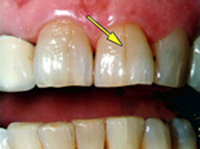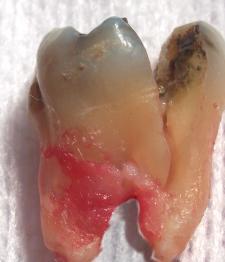Do you have a habit of clenching or grinding your teeth too often? Watch out, for these may be the signs of Syndrome. Read and know all about this dental disorder, including its causes, symptoms, diagnosis and treatment.
Cracked tooth syndrome Definition
Page Contents
- 1 Cracked tooth syndrome Definition
- 2 Types of Cracked Tooth Syndrome
- 3 Cracked Tooth Syndrome Causes
- 4 Cracked Tooth Syndrome Symptoms
- 5 Cracked Tooth Syndrome Diagnosis
- 6 Cracked Tooth Syndrome Treatment
- 7 Cracked Tooth Syndrome Prognosis
- 8 Cracked Tooth Syndrome Risk Factors
- 9 Cracked Tooth Syndrome Prevention
It is a condition characterized by the development of small cracks on teeth, which are too minute to be detected by X-rays. In some cases, the cracks remain hidden under the gums. Technically, this dental disorder is defined as a plain fracture of unknown depth and apparently unnoticeable direction.
There are two classic patterns of this ailment, as observed by researchers. The first one reveals a crack at the center that reaches the dental tubules of the teeth and may even extend up to the pulp. The second crack displays a peripheral orientation resulting in a cuspal fracture. This eventually leads to applied pressure on the crown causing separation of the tooth components near the line of the crack. This soon brings fluids towards the dentinal tubules that stimulate the odontoblast of the pulp and causes it to stretch and rupture.
Types of Cracked Tooth Syndrome
The disease is classified into four types based on etiology. These are as follows:
- Restorative
- Occlusal
- Developmental
- Miscellaneous
Cracked Tooth Syndrome Causes
Know about the causes of the various types of this dental ailment.
Picture 1 – Cracked Tooth Syndrome
Restorative
Factors that may result in this type of dental problem include:
- Deep cusp-fossa relationship
- Over-preparation of the cavities
- Insufficient protection of the outlay or inlay design
- Tensile stress on the cavity walls
Occlusal
It is triggered by any of the factors listed below:
- Masticatory accidents, such as excessive biting or use of excessive force on a piece of bone
- Functional forces, like cyclic and large untreated carious lesions on the teeth
- Parafunction conditions, like Bruxism or grinding of teeth
- Damaging horizontal forces, such as interferences and eccentric contact on the mandibular second molars of the teeth
Developmental
This is seen in unrestored teeth and is caused by incomplete fusion of the teeth areas of calcification.
Miscellaneous
Three factors result in this type of the syndrome, namely:
- Cracks in enamel brought about by thermal cycling
- Lingual barbell brought about by foreign body
- Cracks and crazes (visible cracks in the enamel of the teeth) brought about by high-speed hand pieces used in dental offices during treatment
Cracked Tooth Syndrome Symptoms
The teeth are prone to many injuries and diseases that results in unbearable pain for many. Cracked tooth syndrome may be characterized by a damage (such as a slight crack) observed at the vital posterior of the tooth that affects the dentine up to the pulp. These are more commonly found in the lower back teeth, also known as the molars, probably due to the stress endured during the grinding process. The crack reveals a mesiodistal orientation in the mandibular second molars, the maxillary molars, and the mandibular first molars, which are the most commonly affected teeth. However, there are certain instances wherein a buccolingual orientation may also occur.
The common symptoms of this condition maybe one or more of the following:
- Pain, experienced after exposure to cold air or while chewing
- Spontaneous pain, especially with sweet substances penetrating the cracks of the tooth
- Apparent absence of any spot of dental decay on the tooth
- Non-revelation of problem even after use of x-ray application
- Easy recognition of crack when tooth is prepared for restoration
Cracked Tooth Syndrome Diagnosis
It is difficult, at times even for the patient, to identify a tooth suffering from this condition. However, certain diagnostic methods are quite useful in detecting this disorder. These include:
The Bite Test
This procedure requires the patient to bite on several items like cotton roll, toothpick, wooden stick, burlew wheel, or commercially available Tooth Slooth. Dentists identify the damaged tooth due to the increased pain experienced by a patient while applying pressure on the item during the bite.
Visual Inspection
The technique is conducted by a dentist after the Bite Test. It may involve using a magnifying loupes or specific techniques such as transillumination and dye staining (using methylene blue) to easily identify cracks on the teeth. The process should be conducted by experiences dentists who have the ability to easily spot this condition on the teeth. This is because caries and food may also lead to stains on the teeth making it very difficult to notice the cracks.
The tooth may be assessed further depending on the orientation and size of the cracks on it. Small peripheral cracks may be treated by removing a compromised portion of the damaged tooth and restoring it through composite, pinned amalgam or a sturdy cast restoration. However, large central cracks may require changing treatment options for the disorder.
Cracked Tooth Syndrome Treatment
The treatment of large central cracks varies depending on the condition of the pulp. The list below will guide you on the appropriate treatment option that can be used in case there is:
No Pulpal Involvement
It involves stabilizing the tooth with an orthodontic band or an acrylic crown. Necessary occlusal adjustment is to be made so as to accomplish permanent stabilization and cuspal protection of the tooth. Patients are then provided with the choice of bonded restoration or cast metal restoration. They are given the choice of composite bonded amalgam or full gold crown and gold onlay.
Picture 2 – Cracked Tooth Syndrome Image
Pulpal Involvement
If pulpal involvement is identified at a minimal level the same procedure as mentioned above will be used for its treatment. However, an additional pulpa extirpation has to be performed after the stabilization of the tooth using an orthodontic band. The process is conducted to help monitor and complete the endodontic treatment. Afterwards, patients are given the choice of the manner of proceeding with the tooth restoration procedure.
Cracked Tooth Syndrome Prognosis
In case dentists observe a large central crack and notice extensive damage to the crown, the root and the alveolar bone, extraction is considered to be the only treatment option. It can help prevent infections in the affected teeth or complications in other teeth. However, it is best for patients to ask dentists for any alternative curative options other than extraction and consider its consequences accordingly. Generally, dentists assist patients and guide them on using artificial tooth replacement for their convenience.
Cracked Tooth Syndrome Risk Factors
This is a typical condition experienced by patients in the 30 to 50 year age bracket. It is not isolated to a particular gender but affects both male and female equally.
Cracked Tooth Syndrome Prevention
The condition can be avoided by practicing various preventive measures, such as:
Consulting a dentist
If you are suffering from teeth grinding, immediately seek the assistance of your dentist. Teeth grinding puts the surface of the teeth under too much pressure, causing it to break. A dentist who is experienced in handling the condition can avoid occurrence of such problems.
Avoiding extreme temperatures
Avoid eating extremely hot and extremely cold foods. Extremes of temperatures in the mouth may cause your teeth to become brittle. Be cautious of the food that you eat and refrain from using your molars excessively.
Use mouth guards
Athletic individuals are recommended to use mouth guards to safeguard their teeth in case the mouth receives an accidental blow during sports activities.
Patients should get in touch with a good dentist as soon as they experience any abnormal pain in their gums and teeth. It is best to have the condition diagnosed to avail necessary treatment at the earliest. This will help save the teeth and eliminate hopeless diagnosis of Cracked Tooth Syndrome.
References:
http://en.wikipedia.org/wiki/Cracked_tooth_syndrome
http://users.forthnet.gr/ath/abyss/Cracked-Tooth-Syndrome.htm
http://doctorspiller.com/Cracked_Teeth.htm
http://www.dentistry.com/conditions/teeth-problems/boomers-bruxers-and-cracked-tooth-syndrome


